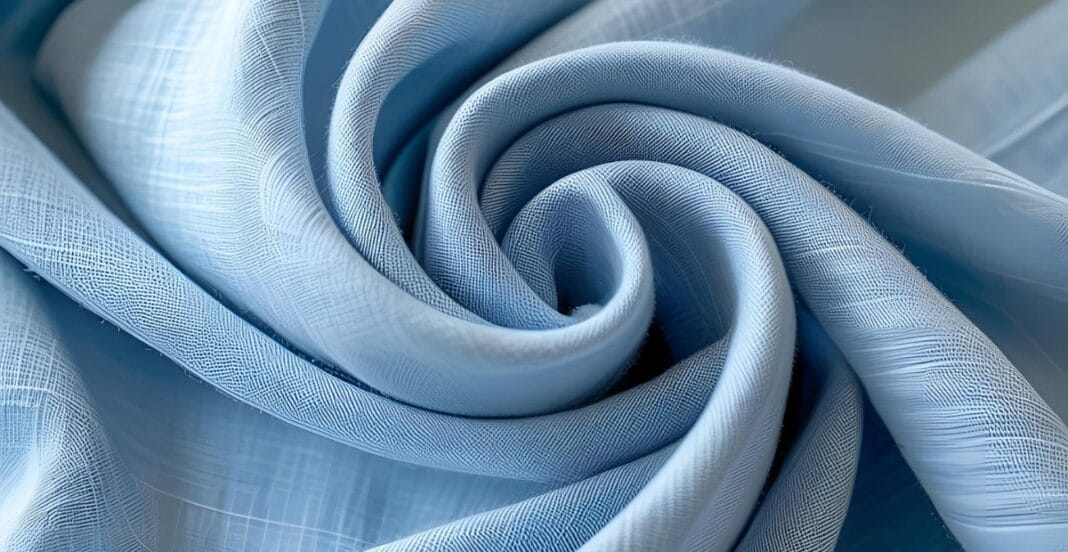Chambray fabric is breathable, soft and timeless. It’s often mistaken for jeans however it has its own distinct appeal. If you are a fan of sewing or style, or just remain comfortable during warmer climates Chambray might be the ideal material to tackle your next sewing project. From dresses and shirts, to curtains and table linens Chambray can be a flexible fabric without sacrificing style. This article will go over all you need to know about chambray, from its beginnings and the types of chambray to the way it’s utilized and adored in everyday life.
Table of contents
- Chambray Fabric
- The Origin and History of Chambray Fabric
- How Chambray Fabric Is Made
- Main Characteristics of Chambray Fabric
- Common Types of Chambray Fabric
- Popular Uses for Chambray Fabric
- Chambray Fabric vs. Denim: Key Differences
- How to Care for Chambray Fabric
- Why Choose Chambray Fabric for Your Next Project?
- Conclusion
- FAQs
Chambray Fabric
Chambray fabric has been around for centuries but it’s fashionable even today. Why? because chambray is practical and sophistication. It is woven with an unstructured weave, which differentiates it from denim, despite the fact that both have the same style. It is a fabric where colored warp threads are interspersed and white weave threads. This creates the unique two-tone effect, as well as the feeling of lightness.
In contrast to denim, chambray is more supple and light. It is also more breathable, making it ideal for wearing in warmer weather. While denim is rough and rigid, chambray is smooth and soft. It’s the reason it’s a favorite option for clothing that requires ease and elegance.
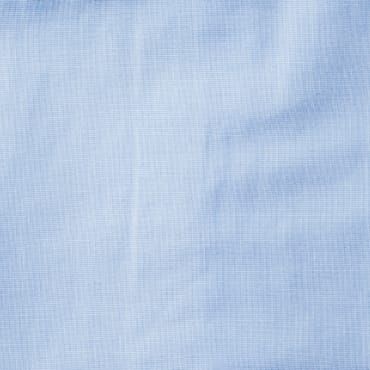
The Origin and History of Chambray Fabric
Chambray fabric originates from Cambrai, a town located in northern France. In the beginning, it was an linen fabric used in household textiles as well as clothes. As time passed, cotton began replacing linen as the primary fiber. Cotton made chambray more supple and a lower cost.
In the 19th century, American farmers and workers began wearing chambray as a uniform. This is the reason you’ve been familiar with the term “blue-collar workers”–many were wearing the chambray shirt. The fabric was a symbol of the hard work of a person and also simple fashion.
Nowadays, chambray fabrics are found in every type of clothing from casual clothing to luxury fashion. Designers are embracing the texture as well as tone since it can be used in a variety of different styles as well as seasons. It’s timeless, but modern.
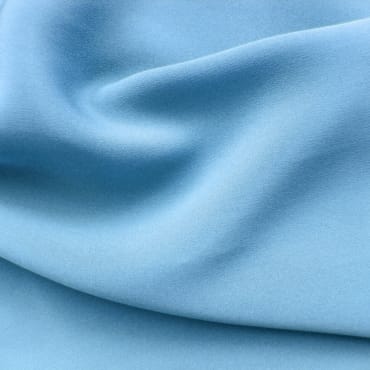
How Chambray Fabric Is Made
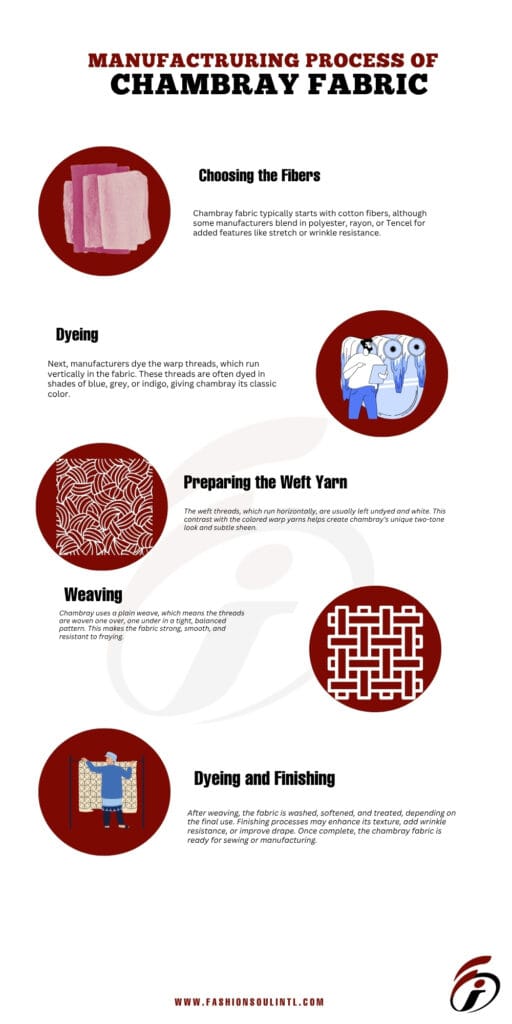
The weave technique creates a unique chambray. It employs a simple weave pattern: one thread over, one thread underneath. This method creates a balanced tight weave that is resistant to fraying and keeps its shape.
The warp thread that runs vertically is typically dyed grey or blue. The weft thread that runs horizontally is white. When they are joined they create an ethereal, light blue cloth with a slight shimmer.
Chambray is mostly made from cotton. Certain versions blend in synthetic fibers, such as rayon or polyester. These blends will make the fabric elastic or wrinkle-resistant, depending on the ratio of blend. However, pure cotton chambray is the one that is loved by all.
Main Characteristics of Chambray Fabric
Chambray fabric has many qualities. It’s light, breathable and simple to clean. It’s quick drying and softens after each wash. It also holds sewing well, which makes it suitable for hand sewing and machine-based projects.
The surface of chambray is textured, yet it’s silky. It doesn’t hold heat like more bulky fabric. This makes it an ideal choice for summer clothing. The fabric can also take dye well, giving many colors that go beyond blue.
Chambray doesn’t stretch much. It’s therefore not suitable for tight, body-hugging clothing. It drapes nicely in loose, flowing clothes. It is often found in boho shirts with wide-leg trousers as well as soft baby clothing.
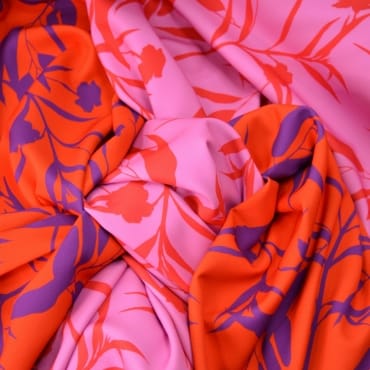
Common Types of Chambray Fabric
The fabric of Chambray comes in numerous kinds, each of which has its intention and the feel. The most popular types are:
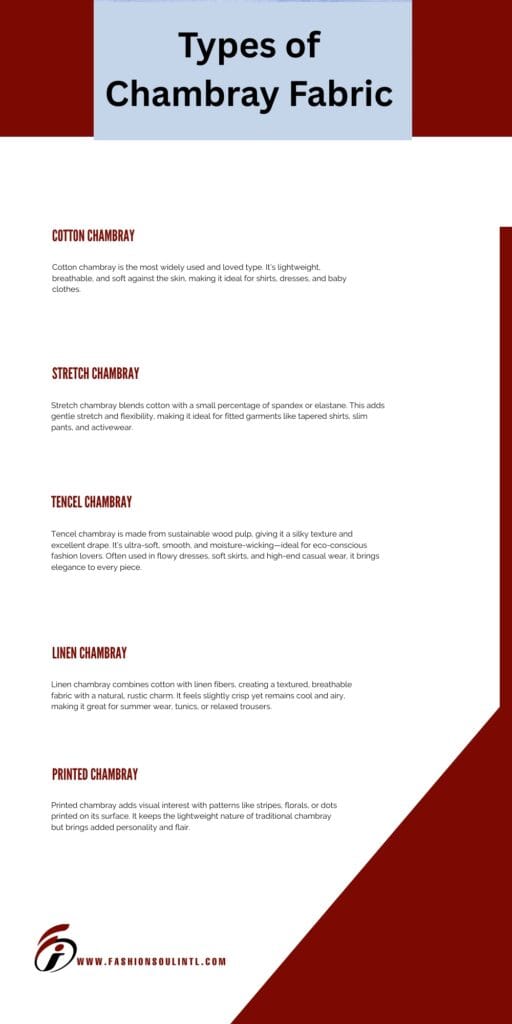
Cotton Chambray
Cotton chambray is the most widely used and loved type. It’s lightweight, breathable, and soft against the skin, making it ideal for shirts, dresses, and baby clothes. Pure cotton also allows for easy dyeing and stitching, giving creators endless design options. It’s perfect for both summer garments and casual everyday wear.
Stretch Chambray
Stretch chambray blends cotton with a small percentage of spandex or elastane. This adds gentle stretch and flexibility, making it ideal for fitted garments like tapered shirts, slim pants, and activewear. It retains the look of classic chambray while offering extra comfort and movement. Great for anyone who values style with a touch of stretch.
Tencel Chambray
Tencel chambray is made from sustainable wood pulp, giving it a silky texture and excellent drape. It’s ultra-soft, smooth, and moisture-wicking—ideal for eco-conscious fashion lovers. Often used in flowy dresses, soft skirts, and high-end casual wear, it brings elegance to every piece. It’s also less prone to wrinkles compared to pure cotton.
Linen Chambray
Linen chambray combines cotton with linen fibers, creating a textured, breathable fabric with a natural, rustic charm. It feels slightly crisp yet remains cool and airy, making it great for summer wear, tunics, or relaxed trousers. It’s ideal for those who love earthy tones and want garments with a relaxed, organic feel.
Printed Chambray
Printed chambray adds visual interest with patterns like stripes, florals, or dots printed on its surface. It keeps the lightweight nature of traditional chambray but brings added personality and flair. Perfect for statement shirts, skirts, or accessories, it allows designers to mix subtle texture with bold prints for unique creations.
Let me know if you want images or sample project ideas for each type!
Each type provides distinct sewing and wear experience. You can select according to your project requirements and personal preference.
Popular Uses for Chambray Fabric

Chambray fabric is extremely versatile. Its soft texture is ideal for a variety of everyday items. Let’s look at the areas which areas chambray shines most.
For fashion fashion, it’s a go-to for skirts, shirts, shorts and dresses. It’s a casual look yet still appears professional. For the wardrobe of men, chambray button-downs are an alternative that is breathable to Oxford cloth.
In interior decor The chambray color is perfect in cushions, curtains or table linens. The gentle blue hue works beautifully with coastal, farmhouse and minimalist styles.
In items for babies Chambray is often utilized in bibs, baby crib rompers, and other nursery items. Its softness makes it gentle on the skin and its weave is durable enough to withstand frequent washing.
Chambray Fabric vs. Denim: Key Differences
The denim and chambray fabrics appear similar on first glance. Both are blue-colored and have strong appearance. However, they differ in terms of structure the weight, texture, and feel.
Chambray is the simple weave whereas denim is a weave of twill. This makes denim more dense and heavier. Chambray can be laid flat and drapes more easily, while denim is an unbending shape.
Another distinction is in their use. Denim is a popular choice for tough clothes like jackets and jeans. Chambray is ideal for more casual items such as blouses and summer dresses.
Both are durable. However, chambray is softer and more comfortable against your skin. If the breathability and comfort are important it is a chambray-colored fabric that wins the day.
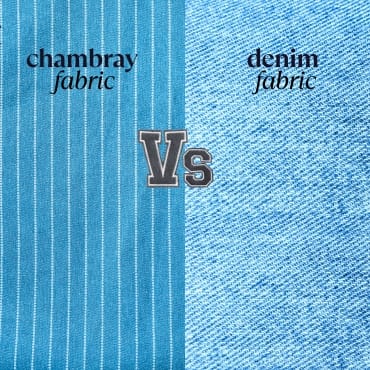
How to Care for Chambray Fabric
Chambray fabric is simple to take care of But a few simple steps will keep it looking new. Always check the label. If the product is 100% cotton you’ll typically be able to wash it with cold water and then tumble dry it on low. For delicate or blended varieties, hand-washing or air drying might be preferred.
Do not use high-heat drying or hot water. These could cause shrinkage and fade. The garments should be turned inside out prior to washing to ensure the fabric’s color. If you need to iron then use a low to medium temperature setting.
When properly maintained Chambray will soften as time passes. It is a beautiful aging fabric that keeps its shape despite many washes.
Creative Projects You Can Make with Chambray Fabric
Chambray fabric offers a myriad of imaginative possibilities. If you sew as a hobby or to earn a living it is an absolute pleasure to use.
Create an Summer dress using Tencel Chambray fabric for the soft, flowing style. Make an classic chambray top that will never go out of fashion. For little ones, design easy-to-wear clothes as well as adorable Rompers.
Home projects consist of napkins, apron sets as well as ornamental pillows. This fabric is also great to make bags, headbands and Table runners.
If you like quilting, you can use the chambray squares to create a vintage look. The combination of softness and strength makes quilts an ideal combination of aesthetics and functionality.
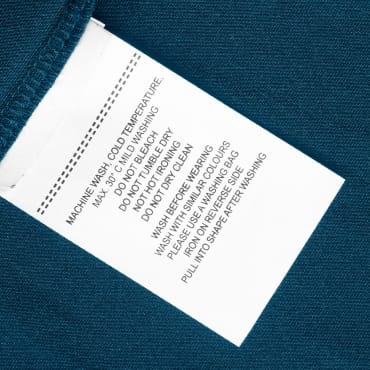
Why Choose Chambray Fabric for Your Next Project?
Chambray fabric can be integrated seamlessly into the modern lifestyle. It’s comfortable, sustainable and timeless. With more people choosing eco-friendly and breathable materials, chambray is a standout.
Its soft, silky feel and elegant style make it a top choice for people of all ages. When you’re sewing clothes or decorating your room it adds the perfect touch of class without a lot of effort.
Fashion-conscious people love it for its sleek lines and relaxed appearance. The makers love how easy it is to sew, cut and press. Anyone wearing it will be amazed by the way light and cool it feels even on the hottest days.
Conclusion
Chambray fabric is proof that style and comfort can be a perfect match. The fabric is well-known in the past, versatile in its use, and stunning in its form. If you’re making fashions, décor or hand-made gifts Chambray allows you the opportunity to create.
It’s soft and strong. Light, but not too heavy. Elegant and practical. Chambray is suitable for every style of life and any level of creative.
If you’ve never done anything with chambray yet it’s time to start. Select your project. Choose your chambray. Let your imagination flow each stitch.
FAQs
Chambray fabric is typically made from cotton. Some blends may include polyester, Tencel, or rayon.
Yes, chambray is breathable and lightweight, making it perfect for warm climates.
Absolutely. It works well for curtains, napkins, and even cushion covers due to its soft drape.

